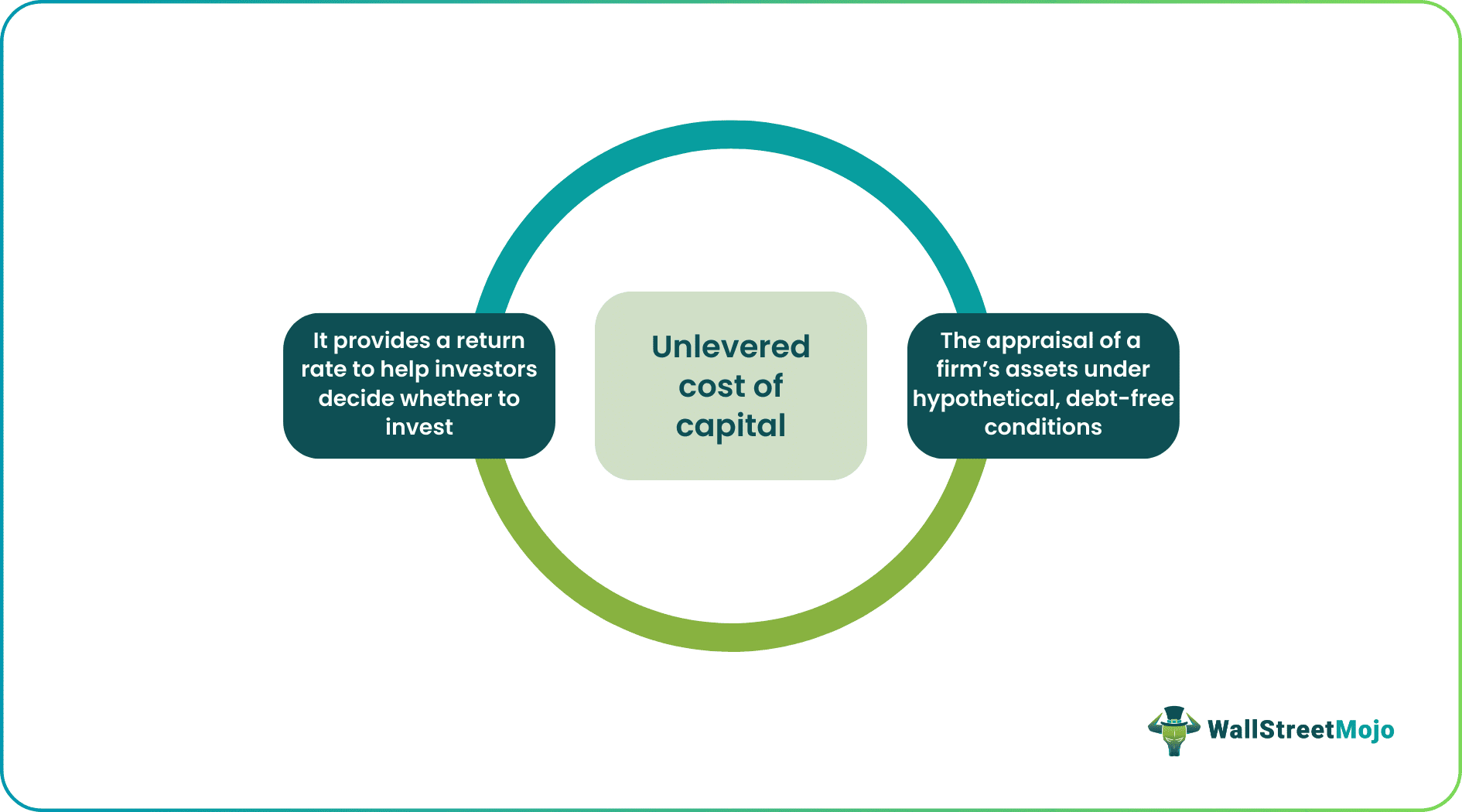Table Of Contents
What Is Unlevered Cost Of Capital?
Unlevered cost of capital refers to the evaluation of the projected rate of return on a firm's assets employing hypothetical circumstances in which there is no debt. Investors use the unlevered cost of capital while estimating the returns on equity in the absence of any debt.

If the firm has an actual debt, the calculation of the unlevered cost of capital becomes theoretical. The cost of a corporation carrying out a capital project is assessed without considering the impact of borrowing. This parameter is very important to investors while evaluating and deciding whether to invest.
Key Takeaways
- Unlevered cost of capital is the appraisal of the expected rate of return on a company's assets under hypothetical conditions in which there is no debt.
- This formula may be used to get the unlevered cost of capital: unlevered cost of capital = risk-free rate plus unlevered beta (Market Risk Premium).
- The weighted average cost of capital (WACC) implies the present capital structure of the firm is utilized for analysis. In contrast, the unlevered cost of capital implies the firm is 100% equity funded.
- A higher unlevered cost of capital is usually the reason why an investor would label stock as high risk.
Unlevered Cost Of Capital Explained
The unlevered cost of capital is an appraisal of a firm that is based on the assumption that the firm will fund itself without taking on any debt. In general, investments and capital projects with such a cost of capital are economical, meaning they are not as costly as activities and projects with a levered cost of capital.
People interested in investing verify the attractiveness of an investment opportunity in a company and the equity returns they are expected to receive when they make a stake in the firm by using the unlevered cost. A firm that reports poor unlevered returns may see a drop in the number of people interested in investing in it, or people may choose not to engage in the company.
As a result of the issue of debt, the costs related to levered cost projects and investments are higher than those related to unlevered cost projects and investments, as they are assumed to be debt-free. The unlevered cost is the one that a company would incur to finance a project without gaining any debt.
If a firm cannot achieve the unlevered returns anticipated, investors may decide not to participate in the company. If all other factors remain the same, an investor could consider a company high risk because it has a higher unlevered capital. This is true even if the investor considers all other factors to be the same.
Unfunded Cost Of Capital With Debt
Even if the firm could have debt, it is necessary to exclude the debt component and its cost to calculate its unlevered component. For example, if it is determined that the unlevered cost of capital is 12% and a firm only has debt at 7%, then its actual cost of capital, also known as its WACC, will be lower than the unlevered cost of capital of 12%. This unlevered cost is still useful, but if the firm cannot deliver the annual unlevered returns of 12% that people in this market expect, investor money may transfer to other available investments. Because of this, the price of the firm's shares will go down.
Formula
Several factors are required to arrive at a proper estimate of the unlevered cost. These variables include the market risk premium, the unlevered beta, and the risk-free rate of return.
The unlevered cost may be arrived at using the below-given formula. Unlevered cost of capital = risk-free rate plus unlevered beta (Market Risk Premium).
ULCC = Risk-free rate + Unlevered Beta * (Expected Market Return - Risk-Free Rate)
The term "Unlevered Beta" refers to the degree to which an investment's volatility differs from that of the market. In comparison, the Market Risk Premium is determined by finding the risk-free return rate and subtracting its expected returns. Unlevered cost of capital calculator is also available on the web.
The user just needs to feed values, and the inbuilt formula will give an answer as output. If the outcome of the computation generates an unlevered cost of 12% and the return on the investment is less than that amount, then it is possible that it is not a good investment choice. However, it is possible to establish real returns by comparing the outcome to the current cost of the firm's debt.
Calculation Example
Let us calculate the unlevered cost using an example to understand the concept better.
ABC Ltd. wants to determine the unlevered cost of the shop. It hires a financial analyst who examines the company's monetary accounts to determine the necessary formula values. The screening allows for the financial analyst is given below. The risk-free rate is 0.30, the unlevered beta is 0.80, and the market risk premium is 0.10. They may now compute the cost of capital without interest. The formula is:
Unlevered cost of capital = risk-free rate + unlevered beta × market risk premium
=0.30+0.8x0.10 =0.30+0.08 =0.38
Using the formula, the analyst finds that the value of the company’s unlevered cost is 0.38, or 38%.

